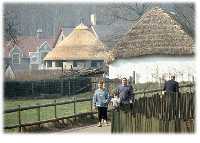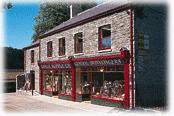The Museum of Welsh Life
 The Museum of Welsh Life, St. Fagans, is one of Europe's biggest and most exciting open-air museums. Centuries of Wales' tradition, culture, industry and costume are gathered together in a hundred acres of beautiful countryside. The Museum gives you the chance to travel from the Celtic village of 2,000 years ago to a miner's cottage of the 1980's.
The Museum of Welsh Life, St. Fagans, is one of Europe's biggest and most exciting open-air museums. Centuries of Wales' tradition, culture, industry and costume are gathered together in a hundred acres of beautiful countryside. The Museum gives you the chance to travel from the Celtic village of 2,000 years ago to a miner's cottage of the 1980's.
Over forty buildings have been taken down stone-by-stone and rebuilt here at St. Fagans to recreate Welsh daily life throughout history. Step back into the past: to the primitive Celtic village; to the bustle of a pre-war grocery; a 19th century farmyard,complete with animals; the chill of a Victorian schoolroom; all these and a 20th century children's playground add up to one of the best days' time-travelling you can find.

The Museum of Welsh Life opened on 7 July 1948. Since then, it has established itself as one of Europe's foremost open air museums, becoming Wales' most popular heritage attraction. The Museum shows how the people of Wales lived, worked and spent their leisure time over the last five hundred years; and over the past fifty years it has inspired generations of visitors with an appreciation of Welsh history and tradition. The Museum stands in the grounds of the magnificent St Fagans Castle, a late 16th century manor house generously donated to the people of Wales by the Earl of Plymouth.
The 100-acre parkland now has over thirty original buildings, moved from various parts of Wales and re-erected to show how the people of Wales lived at various times in history.
The buildings include a school, a chapel and a splendid Workmen's Institute as well as several workshops where craftsmen, such as the blacksmith and the cooper, demonstrate their skills to the public. Their produce is usually on sale.

There are also large indoor galleries housing exhibitions of costume, daily life and farming implements. Special exhibitions are held at regular intervals. The Museum of Welsh Life literally comes to life when traditional festivals and customs and music and dance events are staged throughout the year.
Native breeds of livestock can be seen in the fields and farmyards, and regular demonstrations of farming tasks take place daily. At St Fagans, visitors can gain an insight into the rich heritage and culture of Wales and the Welsh language can be heard in daily use amongst craftsmen and interpretors.